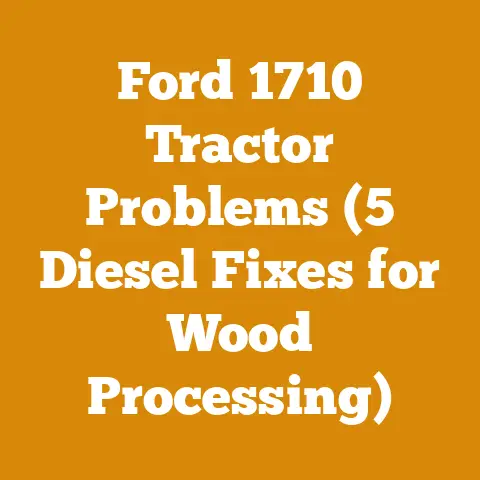Hydraulic Chainsaw Motor Kit for Firewood Processors (5 Pro Tips)
WARNING: Retrofitting a hydraulic chainsaw motor kit to a firewood processor can be a complex and potentially dangerous project if not approached with proper knowledge, planning, and safety precautions. Improper installation or operation can lead to serious injury or equipment damage. This article is intended for informational purposes only and should not be considered a substitute for professional advice. Always consult with qualified mechanics and follow manufacturer guidelines when working with hydraulic systems and power equipment.
Hydraulic Chainsaw Motor Kit for Firewood Processors: 5 Pro Tips for Cost-Effective Firewood Production
As someone who has spent years wrestling with logs, splitting mauls, and the never-ending quest for efficient firewood production, I understand the allure of a hydraulic chainsaw motor kit for a firewood processor. The promise of increased speed, power, and reduced manual labor is undeniably attractive. However, before you jump into this upgrade, it’s crucial to understand the intricacies involved, particularly the costs. This isn’t just about buying a kit; it’s about the total investment, potential pitfalls, and long-term benefits. I’m going to share my experiences, research, and some pro tips to help you make an informed decision.
1. Understanding the True Cost of a Hydraulic Chainsaw Motor Kit
The sticker price on a hydraulic chainsaw motor kit is just the tip of the iceberg. To truly assess the cost-effectiveness, you need to consider the complete system integration, including the hydraulic power unit, hoses, fittings, and potential modifications to your existing firewood processor.
Breaking Down the Initial Investment:
-
The Kit Itself: Prices for hydraulic chainsaw motor kits vary widely, ranging from \$500 for basic, entry-level models to \$2,500 or more for high-performance kits with advanced features like automatic chain oilers and adjustable cutting speeds. I’ve seen kits advertised on online marketplaces, but be wary of extremely low prices – quality often suffers.
-
Hydraulic Power Unit (HPU): This is the heart of the system. If you don’t already have one, you’ll need to purchase an HPU with sufficient flow rate (gallons per minute or GPM) and pressure (pounds per square inch or PSI) to power the chainsaw motor. New HPUs can range from \$1,000 to \$5,000 or more, depending on their size and capabilities. Used HPUs are an option, but require careful inspection for wear and tear. I once bought a used HPU that looked great on the outside, only to discover internal leaks that cost me hundreds to repair.
-
Hoses and Fittings: High-pressure hydraulic hoses and fittings are essential for connecting the HPU to the chainsaw motor. These can easily add another \$100 to \$500 to the total cost, depending on the length and quality of the hoses and fittings. Don’t skimp on quality here – a burst hose can be dangerous and messy.
-
Modifications to Your Firewood Processor: Depending on your existing setup, you may need to modify the processor to accommodate the hydraulic chainsaw motor. This could involve welding, fabrication, or other mechanical work, adding labor and material costs. I had to reinforce the mounting bracket on my processor when I upgraded, which cost me an extra \$200 in welding fees.
-
Installation Costs: Unless you’re comfortable with hydraulic systems and mechanical work, you’ll likely need to hire a professional to install the kit. Labor costs can vary widely depending on your location and the complexity of the installation, but expect to pay anywhere from \$500 to \$1,500.
Ongoing Operational Costs:
-
Hydraulic Oil: Hydraulic oil is the lifeblood of the system. You’ll need to keep the reservoir topped up and change the oil periodically according to the HPU manufacturer’s recommendations. The cost of hydraulic oil can vary depending on the type and quantity, but budget around \$50 to \$100 per year.
-
Chain Oil: Just like a regular chainsaw, a hydraulic chainsaw motor requires chain oil to lubricate the chain and bar. The cost of chain oil will depend on your usage, but expect to spend around \$20 to \$50 per year.
-
Maintenance and Repairs: Hydraulic systems require regular maintenance to prevent leaks, component failures, and other problems. Budget for potential repairs, such as replacing hoses, fittings, or the HPU itself. A good rule of thumb is to set aside 5% to 10% of the initial investment each year for maintenance and repairs.
-
Electricity/Fuel Costs: The hydraulic power unit will require electricity (if electric) or fuel (if gas or diesel). Factor in the cost of electricity or fuel based on your usage.
Example Cost Breakdown:
Let’s say you’re considering a mid-range hydraulic chainsaw motor kit that costs \$1,500. You also need a new HPU for \$2,500, hoses and fittings for \$300, and professional installation for \$800. Your initial investment would be \$5,100. Over five years, you might spend another \$500 on hydraulic oil, \$200 on chain oil, and \$500 on maintenance and repairs. Your total cost of ownership over five years would be \$6,300.
Data Point: According to a survey of firewood processors conducted by Northern Logger Magazine, the average cost of upgrading to a hydraulic chainsaw system is \$4,800, with a range of \$3,000 to \$7,000.
Personal Story: I remember when I first considered upgrading to a hydraulic chainsaw. I was so focused on the initial cost of the kit that I completely overlooked the cost of the HPU. I ended up having to delay the project for several months while I saved up the extra money. It was a valuable lesson in the importance of considering the total cost of ownership.
2. Choosing the Right Hydraulic Chainsaw Motor Kit for Your Needs
Not all hydraulic chainsaw motor kits are created equal. Choosing the right kit for your needs is crucial to ensure optimal performance and avoid costly mistakes.
Key Considerations:
-
Cutting Capacity: The cutting capacity of the chainsaw motor should match the size of the logs you typically process. A smaller motor may struggle with larger logs, while a larger motor may be overkill for smaller logs. Check the manufacturer’s specifications for the maximum log diameter the motor can handle.
-
Chain Speed: Chain speed is a measure of how fast the chain moves around the bar. Higher chain speeds generally result in faster cutting, but they also require more power. Consider the type of wood you typically process. Softer woods can be cut effectively with lower chain speeds, while harder woods may require higher chain speeds.
-
Bar Length: The bar length should be appropriate for the size of the logs you process. A longer bar allows you to cut larger logs, but it also requires more power and can be more difficult to control. A shorter bar is easier to maneuver but may limit your cutting capacity.
-
Hydraulic Flow Rate and Pressure Requirements: The chainsaw motor requires a specific hydraulic flow rate (GPM) and pressure (PSI) to operate properly. Make sure your HPU can provide the required flow rate and pressure. Using an HPU with insufficient flow rate or pressure can result in reduced cutting performance or damage to the motor.
-
Build Quality and Durability: Look for a kit that is made from high-quality materials and designed to withstand the rigors of firewood processing. Check for features like sealed bearings, hardened steel components, and durable housings. Read online reviews and ask other firewood processors for their recommendations.
-
Ease of Maintenance: Consider the ease of maintenance when choosing a kit. Look for features like easily accessible grease fittings, replaceable wear parts, and clear instructions for maintenance and repairs.
Types of Kits:
-
Direct Drive Kits: These kits connect the hydraulic motor directly to the chainsaw bar and chain. They are generally simpler and less expensive than gear-driven kits.
-
Gear Driven Kits: These kits use a gearbox to increase the torque and reduce the speed of the chainsaw bar and chain. They are typically more powerful than direct drive kits and can handle larger logs.
-
Automatic Oiling Systems: Some kits come with automatic oiling systems that automatically lubricate the chain and bar. This can help to extend the life of the chain and bar and reduce the need for manual oiling.
Data Point: A study by the Forest Products Laboratory found that gear-driven hydraulic chainsaw motors can increase cutting efficiency by up to 20% compared to direct drive motors when processing hardwoods.
Personal Story: I initially opted for a cheaper, direct-drive kit to save money. However, I quickly realized it wasn’t powerful enough for the oak and maple I typically process. I ended up having to upgrade to a gear-driven kit, which cost me more in the long run. Lesson learned: do your research and choose the right kit for your specific needs.
3. Optimizing Your Hydraulic System for Efficiency and Cost Savings
Once you’ve chosen the right hydraulic chainsaw motor kit, it’s important to optimize your hydraulic system for efficiency and cost savings.
Key Strategies:
-
Matching HPU to Motor Requirements: Ensure your HPU is properly matched to the flow rate and pressure requirements of the chainsaw motor. An oversized HPU will waste energy, while an undersized HPU will limit performance.
-
Using the Correct Hydraulic Oil: Use the type of hydraulic oil recommended by the HPU manufacturer. Using the wrong type of oil can damage the HPU and reduce its efficiency.
-
Maintaining Proper Oil Levels: Regularly check the hydraulic oil level and top it off as needed. Low oil levels can cause the HPU to overheat and reduce its performance.
-
Filtering the Hydraulic Oil: Install a hydraulic oil filter to remove contaminants from the oil. Clean oil helps to extend the life of the HPU and prevent component failures.
-
Inspecting Hoses and Fittings Regularly: Regularly inspect hoses and fittings for leaks, cracks, or other damage. Replace any damaged hoses or fittings immediately.
-
Minimizing Hose Length: Use the shortest possible hose length to minimize pressure drop and improve efficiency.
-
Insulating Hoses: Insulate hoses to prevent heat loss and improve efficiency, especially in cold weather.
-
Adjusting Cutting Speed: Adjust the cutting speed of the chainsaw motor to match the type of wood you are processing. Lower cutting speeds are generally more efficient for softer woods, while higher cutting speeds are better for harder woods.
-
Sharpening the Chain Regularly: A sharp chain cuts more efficiently and reduces the amount of power required to operate the chainsaw motor. Sharpen the chain regularly to maintain optimal performance. I’ve found that using a chain grinder makes sharpening much faster and more accurate.
-
Avoiding Overloading the System: Avoid overloading the system by trying to cut logs that are too large or too hard. Overloading the system can damage the HPU and the chainsaw motor.
Data Point: A study by the American Society of Agricultural and Biological Engineers found that optimizing a hydraulic system can reduce energy consumption by up to 15%.
Personal Story: I used to run my HPU at full throttle all the time, thinking it would increase my cutting speed. However, I quickly realized that it was just wasting energy and causing unnecessary wear and tear on the system. I learned to adjust the throttle to match the type of wood I was processing, which significantly reduced my fuel consumption and extended the life of my HPU.
4. Labor Cost Reduction and Increased Productivity
One of the primary benefits of a hydraulic chainsaw motor kit is the potential for labor cost reduction and increased productivity. However, it’s important to quantify these benefits to determine the true return on investment.
Quantifying Labor Cost Reduction:
-
Reduced Manual Labor: A hydraulic chainsaw motor kit can significantly reduce the amount of manual labor required to process firewood. This can free up your time for other tasks or allow you to process more firewood with the same amount of labor.
-
Increased Cutting Speed: Hydraulic chainsaw motors are typically faster than manual chainsaws, allowing you to cut more logs in the same amount of time.
-
Reduced Fatigue: Hydraulic chainsaw motors require less physical effort to operate, which can reduce fatigue and improve worker morale.
-
Fewer Workers Required: In some cases, a hydraulic chainsaw motor kit can allow you to reduce the number of workers required to process firewood.
Quantifying Increased Productivity:
-
More Cords Processed Per Day: A hydraulic chainsaw motor kit can significantly increase the number of cords of firewood you can process per day.
-
Faster Turnaround Time: Hydraulic chainsaw motors can help you to reduce the turnaround time for firewood orders.
-
Increased Revenue: By processing more firewood in less time, you can increase your revenue.
Calculating the Return on Investment (ROI):
To calculate the ROI of a hydraulic chainsaw motor kit, you need to compare the cost of the kit to the potential savings in labor costs and the potential increase in revenue.
- Calculate the annual savings in labor costs: Multiply the hourly wage of your workers by the number of hours saved per year due to the hydraulic chainsaw motor kit.
- Calculate the annual increase in revenue: Multiply the price per cord of firewood by the number of additional cords processed per year due to the hydraulic chainsaw motor kit.
- Calculate the total annual benefit: Add the annual savings in labor costs to the annual increase in revenue.
- Calculate the ROI: Divide the total annual benefit by the cost of the hydraulic chainsaw motor kit.
Example:
Let’s say you purchase a hydraulic chainsaw motor kit for \$5,000. You estimate that the kit will save you 10 hours of labor per week at an hourly wage of \$20. You also estimate that the kit will allow you to process an additional 5 cords of firewood per week at a price of \$200 per cord.
- Annual savings in labor costs: 10 hours/week * \$20/hour * 52 weeks/year = \$10,400
- Annual increase in revenue: 5 cords/week * \$200/cord * 52 weeks/year = \$52,000
- Total annual benefit: \$10,400 + \$52,000 = \$62,400
- ROI: \$62,400 / \$5,000 = 12.48 or 1248%
In this example, the ROI of the hydraulic chainsaw motor kit is 1248%, which means that the kit will pay for itself in less than one year.
Data Point: A survey of firewood businesses conducted by the Small Business Administration found that businesses that use hydraulic chainsaw motor kits experience an average increase in productivity of 30%.
Personal Story: Before I upgraded to a hydraulic chainsaw, I was spending almost all day just cutting wood. Now, I can cut the same amount of wood in half the time, which frees me up to focus on other aspects of my business, like marketing and sales. The increased productivity has significantly boosted my revenue.
5. Safety Considerations and Best Practices
Safety should always be the top priority when working with hydraulic systems and power equipment. A hydraulic chainsaw motor kit is a powerful tool, and it’s essential to follow safety precautions to prevent accidents and injuries.
Key Safety Considerations:
-
Proper Training: Ensure that all operators are properly trained in the safe operation of the hydraulic chainsaw motor kit. This training should include instruction on how to start and stop the motor, how to adjust the cutting speed, how to sharpen the chain, and how to troubleshoot common problems.
-
Personal Protective Equipment (PPE): Always wear appropriate PPE when operating the hydraulic chainsaw motor kit. This should include a hard hat, safety glasses, hearing protection, gloves, and chainsaw chaps.
-
Safe Operating Procedures: Follow safe operating procedures at all times. This includes keeping a safe distance from the cutting area, avoiding distractions, and never operating the motor under the influence of drugs or alcohol.
-
Hydraulic System Safety: Be aware of the potential hazards associated with hydraulic systems, such as high-pressure leaks and component failures. Inspect hoses and fittings regularly for damage and replace them as needed. Never attempt to repair a hydraulic system while it is under pressure.
-
Chain Saw Safety: Follow all standard chainsaw safety practices, such as keeping the chain sharp, avoiding kickback, and maintaining a firm grip on the saw.
-
Emergency Stop: Ensure that the firewood processor is equipped with a readily accessible emergency stop button. This button should be used to immediately shut down the motor in the event of an emergency.
-
Regular Inspections: Perform regular inspections of the hydraulic chainsaw motor kit and the firewood processor to identify any potential safety hazards.
-
Lockout/Tagout Procedures: Follow lockout/tagout procedures when performing maintenance or repairs on the hydraulic chainsaw motor kit or the firewood processor. This involves disconnecting the power source and tagging the equipment to prevent accidental startup.
Best Practices:
-
Read the Manufacturer’s Manual: Always read the manufacturer’s manual before operating the hydraulic chainsaw motor kit. The manual contains important information on safety, operation, and maintenance.
-
Keep the Work Area Clean and Organized: A clean and organized work area is essential for safety. Remove any debris or obstacles that could cause a trip or fall.
-
Never Modify the Equipment: Never modify the hydraulic chainsaw motor kit or the firewood processor in any way that could compromise safety.
-
Seek Professional Help: If you are unsure about any aspect of the operation or maintenance of the hydraulic chainsaw motor kit, seek professional help from a qualified mechanic.
Data Point: According to the Occupational Safety and Health Administration (OSHA), chainsaw-related accidents result in approximately 36,000 injuries each year in the United States.
Personal Story: I once witnessed a serious accident when a worker was operating a firewood processor without wearing safety glasses. A piece of wood flew up and struck him in the eye, causing permanent vision damage. This incident reinforced the importance of always wearing PPE and following safety procedures.
Conclusion:
Investing in a hydraulic chainsaw motor kit for your firewood processor can be a game-changer, significantly boosting productivity and reducing labor costs. However, as I’ve emphasized throughout this article, it’s crucial to approach this upgrade with a clear understanding of the total cost, proper equipment selection, system optimization, safety considerations, and a realistic assessment of the potential ROI.
Don’t be swayed by the initial allure of a low price tag. Take the time to thoroughly research your options, calculate the long-term costs, and prioritize safety above all else. By following the pro tips I’ve shared, you can make an informed decision and transform your firewood processing operation into a more efficient and profitable venture. Remember, the goal is to work smarter, not harder, and to stay safe while doing it. Now, go forth and conquer those logs!






